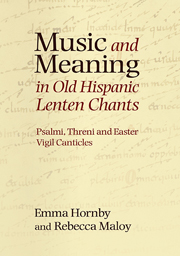Book contents
- Frontmatter
- Contents
- List of Music Examples
- List of Figures
- List of Tables
- Preface
- Abbreviations
- Manuscript Sigla
- Introduction
- CHAPTER 1 Thematic Congruity in the Old Hispanic Lenten Liturgies
- CHAPTER 2 The Threni
- CHAPTER 3 Melodic Language in the Old Hispanic Lenten Psalmi
- CHAPTER 4 Words and Music in the Psalmi
- 5 The Easter Vigil Canticles
- Afterword: Some Thoughts on the Relationship between the Old Hispanic Traditions A and B
- APPENDIX 1 A Guide to Reading Old Hispanic Notation
- APPENDIX 2 The Threni Texts
- Bibliography
- Index of Manuscripts Cited
- Index of Chants Cited
- Index of Scholars Cited
- General Index
- Studies in Medieval and Renaissance Music
Afterword: Some Thoughts on the Relationship between the Old Hispanic Traditions A and B
Published online by Cambridge University Press: 05 December 2013
- Frontmatter
- Contents
- List of Music Examples
- List of Figures
- List of Tables
- Preface
- Abbreviations
- Manuscript Sigla
- Introduction
- CHAPTER 1 Thematic Congruity in the Old Hispanic Lenten Liturgies
- CHAPTER 2 The Threni
- CHAPTER 3 Melodic Language in the Old Hispanic Lenten Psalmi
- CHAPTER 4 Words and Music in the Psalmi
- 5 The Easter Vigil Canticles
- Afterword: Some Thoughts on the Relationship between the Old Hispanic Traditions A and B
- APPENDIX 1 A Guide to Reading Old Hispanic Notation
- APPENDIX 2 The Threni Texts
- Bibliography
- Index of Manuscripts Cited
- Index of Chants Cited
- Index of Scholars Cited
- General Index
- Studies in Medieval and Renaissance Music
Summary
Our examination of the threni, psalmi, and Easter Vigil canticles in previous chapters has renewed the longstanding questions about the status of the tradition B manuscripts and their place in the historiography of the Old Hispanic rite. Each of the genres we have examined has yielded a different perspective on the relationship between the melodies and liturgical traditions preserved in the extant manuscripts. For the threni, T5 and León 8 preserve closely related versions of the melodies and even arrange the threni in the same order. The two traditions also preserve related versions of most Lenten psalmi. In that repertory we have found three different degrees of similarity between the two traditions, ranging from melodies that are very closely related to those that are either distantly related or independent. Our examination of the Easter Vigil in Chapter 5 showed that T5 and León 8 transmit two distinct Old Hispanic liturgies for the Vigil, reflecting different patterns of correspondence with other Western liturgies. In this brief chapter we consider these findings in the light of the history of the two traditions and existing theories about their origins. We also contemplate some directions for further research. While the limited scope of this project does not permit a full exploration of the question, it is clear that no single, linear theory can fully explain the relationship between the two traditions.
- Type
- Chapter
- Information
- Music and Meaning in Old Hispanic Lenten ChantsPsalmi, Threni and the Easter Vigil Canticles, pp. 303 - 314Publisher: Boydell & BrewerPrint publication year: 2013



